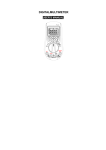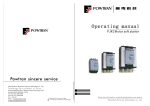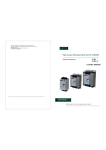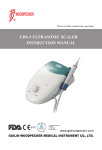Download User's Manual SinoMeter MS8211
Transcript
SinoMeter MS8211 User's Manual WARNING BE EXTREMELY CAREFUL IN THE USE OF THIS METER. Improper use of this device can result in electric shock or destroy of the meter. Follow all safeguards suggested in this manual and the normal safety precautions used in working with electrical circuits. Do not service this device if you are not qualified to do so. To ensure safe operation, and in order to exploit to the full the functionality of the meter, please follow the directions in this section carefully. This meter has been designed according to IEC-1010 concerning electronic measuring instruments with an overvoltage category CAT Ⅲ 600V and pollution 2. Follow all safety and operating instructions to ensure that the meter is used safely and is kept in good operating condition. With proper use and care, the digital meter will give you years of satisfactory service. 1.1 PRELIMINARY 1.1.1 When using the meter, the user must observe all normal safety rules concerning: - Protection against the dangers of electrical current. - Protection of the meter against misuse. 1.1.2 When the meter is delivered, check that it has not been damaged in transit. 1.1.3 When poor condition under harsh preservation or shipping conditions caused, inspect and confirm this meter without delay. 1.1.4 Before using to check for voltage, always test the meter on a known live circuit to verify that the detect function of the meter is working properly. 1.1.5 Test lead or test clip must be in good condition. Before using verify that the insulation on test lead or test clip is not damaged and/or the leads wire is not exposed. 1.1.6 Full compliance with safety standards can be guaranteed only if used with test leads supplied. If necessary, they must be replaced with the same model or same electric ratings. 1.2 DURING USE 1.2.1 Before using, you must select the right function and range. 1.2.2 Never exceed the protection limit values indicated in specifications for each range of measurement. 1.2.3 When the meter is linked to a measurement circuit, do not touch the probe tip of the meter and test lead (or test clip). 1.2.4 At the manual range, when the value scale to be measured is unknown beforehand, select the highest range. 1.2.5 Do not measure voltage if the voltage on the terminals exceeds 600V above earth ground. 1.2.6 Always be careful when working voltages above 60V DC or 30V AC rms, keep fingers behind the probe barrier while measuring. 1.2.7 Never connect the meter leads across a voltage source while the transform switch is in the resistance, diode or continuity mode. Doing so can damage the meter. 1.2.8 Never perform resistance, diode and continuity measurements on live circuits. 1.2.9 ACV detecting is without contact, the probe should be revolved in the meter completely when use, and do not contact the COM jack which at the back of the meter with the test lead (or test clip). 1.2.10 Before rotating the transform switch to change the function, disconnect the tip of meter and the probe of the test lead (or test clip) from the circuit under test. 1.2.11 Never use the meter under the condition of the explosive air, steam or dirt. 1.2.12 If any faults or abnormalities are observed, the meter can not be used any more and it has to be checked out. 1.2.13 Never use the meter unless the rear case is in place and fastened fully. 1.2.14 Please do not store or use meter in areas exposed to direct sunlight, high temperature, humidity or condensation. 1.3 SYMBOLS Important safety information, refer to the operating manual. Double insulation(Protection class((). CAT ((( Overvoltage (Installation) category III, Pollution Degree 2 per IEC1010-1 refers to the level of Impulse Withstand Voltage protection provided. Conforms to european union directive Earth ground AC Alternating current DC Direct current AC or DC (alternating current or direct current) Diode Continuity buzzer M.H The maximum value is being held. D-H This indicates that the display data is being held. AUTO Auto range The battery is not sufficient for proper operation. 1.4 MAINTENANCE 1.4.1 Please do not attempt to adjust or repair the meter by removing the rear case while voltage is being applied. A technician who fully understands danger involved should only carry out such actions. 1.4.2 Before opening the battery cover or case of the meter, always disconnect the tip of meter and the probe of the test lead (or test clip) from all tested circuits. 1.4.3 To avoid the wrong reading causing electricity attack, when the meter displays“ ”, you must change the battery. 1.4.4 Do not use abrasives or solvents on the meter, use a damp cloth and mild detergent only. 1.4.5 Always set the transform switch to the OFF position when the meter is not in use. 1.4.6 If the meter is to be stored for a long period of time, the batteries should be removed to prevent damage to the unit. 2. DESCRIPTION - This meter is a portable professional measuring instrument with handsome LCD easily reading. - Single operation of a transform switch makes measurement convenient. Overload protection and low battery indication are provided, this meter is ideal for use in the fields, workshop, school, hobby and home applications. - Non-contact detecting is convenient to test the socket or the lead whether is with power or not. - This meter has function of auto range and manual range. - This meter has function of auto power off. - This meter is with the functions of data hold and maximum value measure and hold. - When using, it can show ranges engineering unit enunciators measuring results. 2.1 NAMES OF COMPONENTS ⑴ Probe ⑵ Rotatable Probe Socket ⑶ LED Indicator ⑷ Protection Ring ⑸ Transform Switch ⑹ Sensitivity Adjust Knob ⑺ FUNC. Button ⑻ RANGE Button ⑼ MAX.H Button ⑽ DATA-H Button ⑾ Panel ⑿ LCD Display ⒀ COM Jack 2.2 COMPONENTS ELUCIDATION - RANGE Button This button is used to transform Auto range or manual range. - FUNC. Button This button is used to transform function. - DATA-H Button This Button is used to hold data. - MAX.H Button This button is used to measure and hold the maximum value. - Transform Switch This switch is used to select functions and desired ranges. - Probe Input terminals for V/Ω/ / and AC voltage detector. - COM Jack Common terminal for measurement. - LCD Display At V/Ω/ / range, the measuring result can be displayed. - LED Indicator At TEST range, ACV detecting result can be indicated. - Rotatable Probe Socket Rotating the probe in or out of the meter. - Protection Ring To keep the hand from the probe behind the ring. - Sensitivity Adjust Knob To adjust the sensitivity while ACV detecting. 3. SPECIFICATIONS Accuracy is specified for a period of year after calibration and at 18℃ to 28℃(64℉ to 82℉)with relative humidity to 75%. 3.1 GENERAL SPECIFICATIONS 3.1.1 Auto ranges and manual range. 3.1.2 Max. Voltage Between Terminals And Earth Ground: 600V DC or AC 3.1.3 Operating Altitude: 2000 meters (7000 ft.) maximum 3.1.4 Display: 20mm LCD 3.1.5 Max. Show Value: 1999 (3 1/2) 3.1.6 Polarity Indication: ‘-’indicates negative polarity. 3.1.7 Overrange Indication: Display ‘OL’ 3.1.8 Sampling Time: approx. 0.4 second 3.1.9 Unit showing: showing of function and electrical capacity. 3.1.10 Low Battery Indication: ‘ ’ displayed 3.1.11 Auto power off time: 15 min. 3.1.12 Power Supply: 1.5V×2 AAA battery. 3.1.13 Operating Temperature: 0℃ to 40℃(32(F to 104(F) 3.1.14 Storage Temperature: -10℃ to 50℃(10(F to 122(F) 3.1.15 Dimension: 208×38×29 mm 3.1.16 Weight: approx. 110g(including battery) 3.2 ELECTRICAL SPECIFICATIONS Circumstance Temperature: 23(5℃ Relative Humidity: < 75% 3.2.1 DC Voltage Range Resolution 200mV 0.1mV 2V 0.001V 20V 0.01V 200V 0.1V 600V 1V Accuracy ±(0.7% of rdg + 2 digits) - Input Impedance: 10MΩ - Overload Protection: 200mV range: 250V DC or AC rms, 2V-600V ranges: DC 600V or AC 600V rms. - Max. Input Voltage: 600V DC 3.2.2 AC Voltage Range Resolution 200mV 0.1mV 2V 0.001V 20V 0.01V 200V 0.1V 600V 1V Accuracy ±(0.8% of rdg + 3 digits) ±(1.0% of rdg + 3 digits) - Input Impedance: 10MΩ - Overload Protection: 200mV range: 250V DC or AC rms, 2V-600V ranges: DC 600V or AC 600V rms. - Frequency Range: 40 to 400Hz - Response: Average, calibrated in rms of sine wave. - Max. Input Voltage: 600V rms AC 3.2.3 Resistance Range Resolution Accuracy 200Ω 0.1Ω ±(1.0% of rdg + 3 digits) 2kΩ 0.001kΩ 20kΩ 0.01kΩ 200kΩ 0.1kΩ 2MΩ 0.001MΩ 20MΩ 0.01MΩ ±(1.0% of rdg + 1 digit) ±(1.0% of rdg + 5 digits) - Open Circuit Voltage: 0.25V - Overload Protection: 250V DC or rms AC 3.2.4 Continuity Range Function Built-in buzzer will sound, if resistance is lower than 50(. - Open circuit voltage: approx. 0.5V - Overload Protection: 250V DC or rms AC 3.2.5 Diode Range Resolution Function 0.001V Display :read approximate forward voltage of diode - Forward DC Current: approx. 1mA - Reversed DC Voltage: approx.1.5V - Overload Protection: 250V DC or rms AC 3.2.6 AC Voltage Detect Range TEST Sensitivity Voltage sensitivity >50V, adjust continuously Frequency 50Hz Distance <150mm(change along with the sensitivity) - Non-contact detecting 4. OPERATING INSTRUCTION 4.1 DATA HOLD If you need data hold when measuring, you can put on “DATA-H” button, it will hold the reading; if you put the button again, data hold is not continue. 4.2 MAXIMUM VALUE MEASURING AND HOLD At the range of voltage, you can put on “MAX.H” button, it will hold the maximum value; if you put the button again, the maximum value will not be held. 4.3 FUNCTION TRANSFORM Put down the "FUNC." when measuring the voltage. Meter will be transformed between DC and AC range. Put "FUNC." when measuring the resistance, diode and continuity, meter will transform among them. 4.4 RANGE TRANSFORM The auto range is used when measuring the voltage and resistance. Put down the "RANGE" if the manual range is needed. Each time you put down, range will go upward; the minimum range is transformed if "RANGE" is put down at the maximum range. If the "RANGE" is put down more than two seconds, auto range is used again. 4.5 AUTO POWER OFF If there’s no any operation within fifteen minutes after power is on, meter will auto power off with five short sounds and a long sound in a minute. After auto power off, if stir the transform switch or put down any button of “FUNC.”, “DATA-H”, ”MAX.H”, ”RANGE”, meter will recover the working condition. If presses the “FUNC.” when power is on, auto power off disable. NOTE: At the TEST range (ACV detecting), there is no auto power off function 4.6 PREPARATION FOR MEASUREMENT 4.6.1 Set the transform switch to the right range. At the manual range, when the value scale to be measured is unknown beforehand, select the highest range. 4.6.2 When measuring, at first, connect to the public (COM) testing line, then connect the probe tip of the meter to the circuit under test. 4.6.3 If the battery voltage is less than 2.4V, display will show “ ”, the battery should be changed at this time. 4.7 DC VOLTAGE MEASURING WARNING Risk of Electrocution. You can’t input the voltage which is higher than 600V DC, it’s possible to show higher voltage, but it may damage the inner circuit or cause electrical shock. Pay attention to avoid getting an electric shock when measuring high voltage. 4.7.1 Rotate the probe socket clockwise to spin out the probe from the meter. 4.7.2 Insert the black test lead or test clip in the COM jack. 4.7.3 Set the transform switch at the V range position. 4.7.4 Press the "FUNC." Button to transform to DC measurement. Auto range and manual ran ge can be transformed by pressing the “RANGE” button. 4.7.5 Connect the probe tip of the meter and probe tip of the test lead (or test clip) across the power source or be loaded on the two sides under measurement. 4.7.6 You can get a reading from LCD display. The polarity of the tested terminal which the tip of the meter connection will be indicated. NOTE: - At the little voltage range, the meter will show unsteady reading when test leads haven’t reach the circuit, it’s normal because the meter is very sensitivity. When meter touch the circuit, you can get the true reading. - At the manual range mode, when only the figure ‘OL’ is displayed, it indicates overrange situation and the higher range has to be selected. - At the manual range mode, when the value scale to be measured is unknown beforehand, select the range to the highest position and set down gradually. 4.8 MEASURING AC VOLTAGE 4.8.1 Rotate the probe socket clockwise to spin out the probe from the meter. 4.8.2 Insert the black test lead or test clip in the COM jack. 4.8.3 Set the transform switch at the V range position. 4.8.4 Auto range and manual range can be transformed by putting the “RANGE”. 4.8.5 Connect the probe tip of the meter to one side of the tested circuit and probe tip of the test lead (or test clip) to the other side. 4.8.6 You can get reading from LCD display. WARNING Risk of Electrocution. You can’t input the voltage which is higher than 600V rms AC, it’s possible to show higher voltage, but it may damage the inner circuit or cause electrical shock. Pay attention to avoid getting an electric shock when measuring voltage. NOTE: - At the manual range mode, when only the figure ‘OL’ is displayed, it indicates overrange situation and the higher range has to be selected. - At the little voltage range, the meter will show unsteady reading when test leads haven’t reach the circuit, it’s normal because the meter is very sensitivity. When test leads touch the circuit, you can get the true reading. - At the manual range mode, when the value scale to be measured is unknown beforehand, select the range at the highest position and set down gradually. - Transform to the manual range when use the mV range. 4.9 MEASURING RESISTANCE 4.9.1 Rotate the probe socket clockwise to spin out the probe from the meter. 4.9.2 Insert the black test lead or test clip in the COM jack. 4.9.3 Set the transform switch at the ( range position. Auto range or manual range can be transformed by putting the “RANGE”. 4.9.4 Connect the probe tip of the meter to one side of the tested circuit and probe tip of the test lead (or test clip) to the other side. 4.9.5 You can get reading from LCD display. WARNING Risk of Electrocution. When measuring in-circuit resistance, be sure the circuit under test has all power removed and that all capacitors have been discharged fully. NOTE: - At the manual range mode, when only the figure ‘OL’ is displayed, it indicates overrange situation and the higher range has to be selected. - For measuring resistance above 1MΩ, the meter may take a few seconds to get stable reading. - When the input is not connected, i.e. at open circuit, the figure ‘OL’ will be displayed for the overrange condition. 4.10 TESTING DIODE 4.10.1 Rotate the probe socket clockwise to spin out the probe from the meter. 4.10.2 Insert the black test lead or test clip in the COM jack. 4.10.3 Set the transform switch at the range position. 4.10.4 put down the "FUNC." transformed at test. 4.10.5 Connect the probe tip of the meter to the anode of the diode, the black test lead (or test clip) to the cathode of the diode. 4.10.6 You can get reading from LCD display. NOTE: - The meter will show the approximate forward voltage drop of the diode. - If the meter and the lead connection is reversed, only figure ‘OL’ will be displayed. - When the input is not connected, i.e. at open circuit, the figure ‘OL’ will be displayed. 4.11 CONTINUITY TEST WARNING Risk of Electrocution. When testing the circuit continuity, be sure that the power of the circuit has been shut down and all capacitors have been discharged fully. 4.11.1 Rotate the probe socket clockwise to spin out the probe from the meter. 4.11.2 Insert the black test lead or test clip in the COM jack. 4.11.3 Set the transform switch at the range position. 4.11.4 Put down the "FUNC." transformed at continuity test. 4.11.5 Connect the probe tip of the meter to one side of the tested circuit and probe tip of the test lead (or test clip) to the other side. 4.11.6 If continuity exists (i.e., resistance less than about 50Ω), built-in buzzer will sound. NOTE: - If the input open circuit (or the circuit resistance measured is higher than 200Ω), then the figure‘0L’ will be displayed. 4.12 AC VOLTAGE DETECT WARNING Risk of Electrocution. When detecting pay attention to avoid getting an electric shock. Before using to check for voltage in an outlet, always test the meter on a known live circuit to verify that the AC voltage detect function of the meter is working properly. keep fingers behind the probe barrier while measuring. 4.12.1 Rotate the probe socket anti-clockwise to spin the probe into the meter. 4.12.2 Set the transform switch at the V range position. 4.12.3 Be sure that the display is not shown “ ”, otherwise, the battery should be replaced. 4.12.4 Set the transform switch to the TEST range. Then the green LED of the LED Indicator is bright. 4.12.5 Rotate the sensitivity adjusting knob in the middle of the transform switchanti-clockwise, set the meter to the highest detecting sensitivity in order to enlarge the detecting range. 4.12.6 Put the probe socket close to the lead or the power socket, If AC electrical voltage is present, the red LED Indicator which in front of the meter will flash and the audible warning will sound. 4.12.7 In the places with many leads and jacks, rotate the sensitivity adjusting knob in the middle of the transform switch clockwise, set the meter to the lower detecting sensitivity in order to confirm which one is electriferous. NOTE: - When using ACV detecting function, always set the meter to the highest sensitivity. - In this range, even though there is no any sound and light indication, the meter will still consume electricity. - There is no auto power off function in this range. - Always set the power switch to the OFF position when the meter is not in use. 5. MAINTENANCE 5.1 BATTERY REPLACEMENT WARNING Before attempting to open the battery cover of the meter, be sure that the probe tip of the meter and test lead (or test clip) have been disconnected from measurement circuit to avoid electric shock hazard. 5.1.1 If the sign ‘ ’ appears on the LCD display, it indicates that the battery should be replaced. 5.1.2 Loosen the screw fixing the battery cover and remove it. 5.1.3 Replace the exhausted battery with a new one. 5.1.4 Put the battery cover as its origin. 5.2 TEST LEADS (OR TEST CLIP) REPLACEMENT WARNING Full in compliance with safety standards can be guaranteed only if used with test leads supplied. If necessary, they must be replaced with the same model or same electric ratings. Electric ratings of the test leads: 600V 10A. You must be replaced the test lead if the lead is exposed. 6. ACCESSORIES ⑴ Test Lead: Electric Ratings 600V 10A one piece ⑵ Test Clip: Electric Ratings 600V 10A one piece ⑶ Battery:1.5V, AAA two pieces ⑷ Instruction Manual one piece























